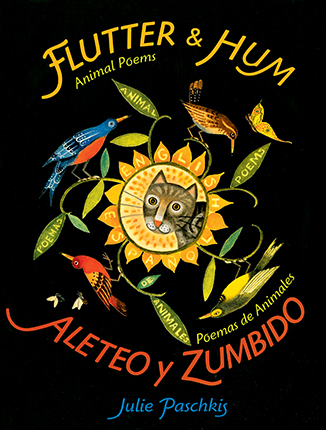Full Text Reviews: School Library Journal - 05/01/2015 K-Gr 4—An excellent Spanish-English collection of poetry on animals. In an author's note, Paschkis explains that although she is neither a poet nor a native Spanish speaker, she was inspired by the work of Chilean poet Pablo Neruda and that she began writing these poems in Spanish and then translated them into English. The Spanish and English poems are on opposite facing pages, with the artwork seamlessly sewing both versions together. Rendered in gouache, the folk-art inspired illustrations are at times dazzling with their use of color and subdued at others, as in the light, sage greens and grays of "Heron." Though Paschkis employs beautiful use of language in the English versions, such as her poem about a turtle who keeps jewels in her box ("When she walks/she listens to the rattle of the gemstones") and another about a dog whose wagging tail "fans wild happiness" into the world, the Spanish translations are marred by some awkward phrasing. VERDICT A book that takes wing and flies, flutters, and sometimes falters.—Teresa Pfeifer, The Springfield Renaissance School, Springfield, MA - Copyright 2015 Publishers Weekly, Library Journal and/or School Library Journal used with permission. Bulletin for the Center... - 07/01/2015 Picture book criticism talks a lot about the relationship between the text and illustration, about using each art form to speak to the other to create a unified whole. Occasionally, a bilingual book (almost always a poetry book) manages to achieve similar complementary with its paired texts, as did Lori Carlson’s Cool Salsa (BCCB 9/94). Now Julie Paschkis has managed to achieve such a relationship between art and text and between text in two languages at the same time, in an alchemy that results in a cohesive yet multi-faceted whole. Probably best known to date as an illustrator, Paschkis comes to the fore here as a poet as well in this bilingual collection of fourteen animal-themed poems. The poems treat mammals and birds, insects and fish, and they are each titled the singular name of the subject animal (“Crow,” “Dog,” “Fly,” in English without an article as if the poems were about the platonic ideal of each creature). These are bijou short-lined verses; the longest is fourteen lines, with only a few words per line, and the shortest four lines, but the poems’ compactness gives them additional impact. And though the style is playful and musing, the verses are slyly intricate and stealthily well crafted; the poems are sometimes decorated with alliteration, sometimes rhyming, though in capricious rather than organized form. While some are haiku-like impressions (“Crow”), others trip to a satisfying stop (the “Snake” who “only knows/ one letter:/ ssssssssss”), mixing one kind of poetic pleasure with another. The poems in English would be pleasing enough on their own, but they’re not on their own. The author created both the English and Spanish texts and didn’t simply translate one into the other; she worked initially in Spanish and then revised back and forth between the two to ensure the poems were successful individually as well as being mutually reflective. The result is a truly bilingual book: it avoids the seeming English prioritization of many dual-language texts, and it offers special treats in both versions that mean readers—and, especially, readers-aloud—who skip one language will miss half the show. For instance, some Spanish poems offer alliteration where the English poem plays with rhyme and vice versa, and some elegant or capering turns appear only in one language (the Spanish text for “Whale” offers the delicious and inimitable wordplay of “la ballena bailarina”—the dancing whale). The gouache illustrations wittily weave relevant words in English and Spanish into the landscape and even the animals, often creating a poem all their own—the turtle’s patterned shell reads “Go,” “Glow,” “Glisten,” “Listen” on the English verso and “Goce,” “Gema,” “Lustra,” “Llena” on the Spanish recto. Compositions dance delicately between the ornate (the curly-tailed, curly-patterned cats), the spare (the huge strawberry flanked by a fly on each side), and the fluid (a spume of linear dots impels the whales forward), while there’s definite progress toward the nocturnal in the last few poems, ending with the bedtime poem of “Fish.” This is a celebration in text and art of words, of language, and of the spaces between and their possibilities. Appropriately enough, the book itself is also filled with possibilities—for reading aloud, for performing, for general language arts use—and kids will savor it however they meet it. A detailed author/illustrator’s note explains her process. (See p. 560 for publication information.) Deborah Stevenson, Editor - Copyright 2015 The Board of Trustees of the University of Illinois. Loading...
|



